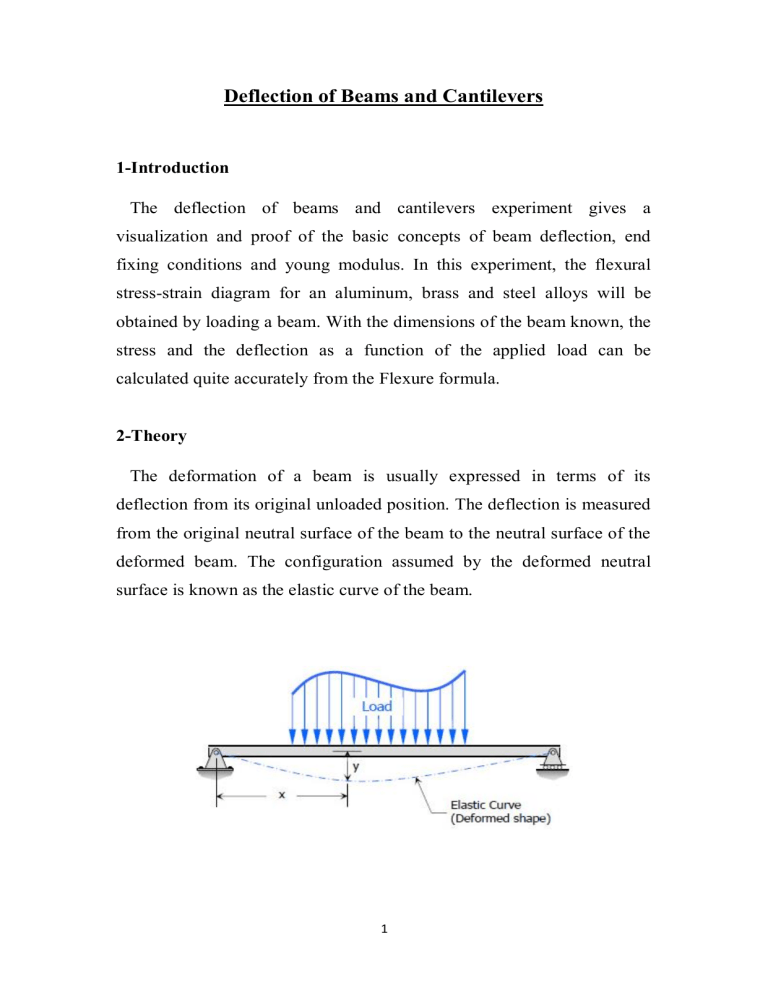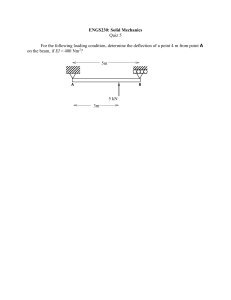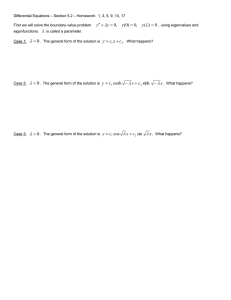
Deflection of Beams and Cantilevers 1-Introduction The deflection of beams and cantilevers experiment gives a visualization and proof of the basic concepts of beam deflection, end fixing conditions and young modulus. In this experiment, the flexural stress-strain diagram for an aluminum, brass and steel alloys will be obtained by loading a beam. With the dimensions of the beam known, the stress and the deflection as a function of the applied load can be calculated quite accurately from the Flexure formula. 2-Theory The deformation of a beam is usually expressed in terms of its deflection from its original unloaded position. The deflection is measured from the original neutral surface of the beam to the neutral surface of the deformed beam. The configuration assumed by the deformed neutral surface is known as the elastic curve of the beam. 1 Numerous methods are available for the determination of beam deflections. These methods include: 1. Double-integration method 2. Area-moment method 3. Strain-energy method (Castigliano's Theorem) 4. Conjugate-beam method 5. Method of superposition Of these methods, the first two are the ones that are commonly used. 2-1 double integration method The double integration method is a powerful tool in solving deflection and slope of a beam at any point because we will be able to get the equation of the elastic curve. In calculus, the radius of curvature of a curve y = f(x) is given by In the derivation of flexure formula, the radius of curvature of a beam is given as: Deflection of beams is so small, such that the slope of the elastic curve dy/dx is very small, and squaring this expression the value becomes practically negligible, hence: 2 Thus, EI / M = 1 / y'' If EI is constant, the equation may be written as: where x and y are the coordinates shown in the figure of the elastic curve of the beam under load, y is the deflection of the beam at any distance x. E is the modulus of elasticity of the beam, I represent the moment of inertia about the neutral axis, and M represents the bending moment at a distance x from the end of the beam. The product EI is called the flexural rigidity of the beam. The first integration y' yields the slope of the elastic curve and the second integration y gives the deflection of the beam at any distance x. The resulting solution must contain two constants of integration since EI y" = M is of second order. These two constants must be evaluated from known conditions concerning the slope deflection at certain points of the beam. For instance, in the case of a simply supported beam with rigid supports, at x = 0 and x = L, the deflection y = 0, and in locating the point of maximum deflection, we simply set the slope of the elastic curve y' to zero. 3 2-2 Beam Deflections (Area-Moment Method) Another method of determining the slopes and deflections in beams is the area-moment method, which involves the area of the moment diagram. Theorem I The change in slope between the tangents drawn to the elastic curve at any two points A and B is equal to the product of 1/EI multiplied by the area of the moment diagram between these two points. Theorem II The deviation of any point B relative to the tangent drawn to the elastic curve at any other point A, in a direction perpendicular to the original position of the beam, is equal to the product of 1/EI multiplied by the 4 moment of an area about B of that part of the moment diagram between points A and B. and Rules of Sign The deviation at any point is positive if the point lies above the tangent, negative if the point is below the tangent. Measured from left tangent, if θ is counterclockwise, the change of slope is positive, negative if θ is clockwise. 2-2-1 Deflection of Cantilever Beams | Area-Moment Method Generally, the tangential deviation t is not equal to the beam deflection. In cantilever beams, however, the tangent drawn to the elastic curve at the wall is horizontal and coincidence therefore with the neutral axis of the beam. The tangential deviation in this case is equal to the deflection of the beam as shown below. 5 From the figure above, the deflection at B denoted as δB is equal to the deviation of B from a tangent line through A denoted as tB/A. This is because the tangent line through A lies with the neutral axis of the beam. 2-2-2 Deflections in Simply Supported Beams | Area-Moment Method The deflection δ at some point B of a simply supported beam can be obtained by the following steps: 1. Compute 2. Compute 3. Solve δ by ratio and proportion (see figure above). 3-Description of the apparatus The apparatus consists of a backboard with a digital dial gage which have a sliding movement along the test beam. Two rigid clamps mount on the backboard and can hold the beam in any position. Two knife- edge 6 supports also fasten anywhere along the beam. scales printed on the backboard allow quick and accurate positioning of the digital dial test indicator, knife-edges and loads. Fig.1: A schematic for the apparatus The masses supplied with the equipment give maximum flexibility and ease of use (Fig.2). 7 Fig.2: Hanger loaded with masses Figure (3) shows the deflection of beams and cantilevers experiment assembled in the structures test frame. Fig.3: The assembled beam tested apparatus. 8 4-Experimental Procedures 1. place the assembled test frame on the workbench. 2. there are two securing nuts in each of the side members of the frame (on the inner track). Slide them to roughly the positions indicated by the thumbscrews shown in figure3. 3-lift the backboard into position and have an assistant secure the back board by threading the thumbscrews into the securing nuts .if necessary, level the backboard by loosening the thumbscrews on one side , repositioning the backboard, and tightening the thumbscrews. In the first part of this experiment, the deflection of a simply supported beam subjected to an increasing point load must be measured to establish again the load deflection relationship. 9 Mass Actual deflection Theoretical deflection (g) (mm) (mm) 0 0 0 100 0.40 0.43 200 0.78 0.85 300 1.18 1.28 400 1.60 1.70 500 2.00 2.13 Typical results for experiment (fixed beam length variable load) 10 In the second part of the experiment, the beam length must be varied to establish the relationship between the deflection and the cube of the beams length. length 𝑙𝑒𝑛𝑔𝑡ℎ3 deflection (m) (𝑚)3 (mm) 200 0.008000 0.27 260 0.017576 0.55 320 0.032768 1 380 0.054872 1.7 440 0.085184 2.6 500 0.125000 3.87 560 0.175616 5.5 Typical results for experiment (fixed beam load variable length) 11 5-Discussion 1- Discuss the proportional relationship between the applied load and the beam deflection. 2- Examine the fundamental relationship between beam deflection and the cube of the beam length. 3- Why is stress not directly measurable? 4- Is there any deviation between experimental and theoretical results? Discuss that. 12





